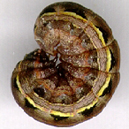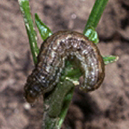Cutworms
Pest Management Fact Sheet #5015
James F. Dill, Pest Management Specialist
Clay A. Kirby, Insect Diagnostician
For information about UMaine Extension programs and resources, visit extension.umaine.edu.
Find more of our publications and books at extension.umaine.edu/publications/.
Description & Biology
 Cutworms are categorized as surface, climbing, army or subterranean. Because of their many similarities, it is often difficult to tell one species of cutworm from another. However, there is variation in the life cycle of different species. In Maine, many cutworms have only one generation per year, although some can produce two generations.
Cutworms are categorized as surface, climbing, army or subterranean. Because of their many similarities, it is often difficult to tell one species of cutworm from another. However, there is variation in the life cycle of different species. In Maine, many cutworms have only one generation per year, although some can produce two generations.
 Some cutworm caterpillars cut off young plants, and stunt or kill taller plants by feeding on underground roots and stems. Corn, peppers, tomatoes, and beans are their favorite food, but they will attack many kinds of plants. Other cutworms climb up stems and feed on leaves. Cutworm larvae are nocturnal, so with the possible exception of dark/wet days, they will spend daylight hours hiding in the soil.
Some cutworm caterpillars cut off young plants, and stunt or kill taller plants by feeding on underground roots and stems. Corn, peppers, tomatoes, and beans are their favorite food, but they will attack many kinds of plants. Other cutworms climb up stems and feed on leaves. Cutworm larvae are nocturnal, so with the possible exception of dark/wet days, they will spend daylight hours hiding in the soil.
Most Maine cutworm species overwinter in the late larval or pupal stage. The brownish gray moths may appear shortly after warm weather arrives. The moths are attracted to weedy fields, especially if mustard or quackgrass is present. They also may lay their eggs in weedy, overgrown gardens before spring planting.
Once gardens are planted, the young larvae feed on small roots until they are half grown, or about 3/4 inches long. After that, they become more likely to cut off plants at ground level. They may drag part of the plant down into the soil, where they hide during the day. The larvae can usually be found hiding in the soil in the daytime close to a cut plant. The thick-bodied larvae are normally dark-colored and curl up when disturbed.
Management
The most important means of controlling cutworms is to avoid planting in soil that was sod-covered in the previous year or two and to keep crop areas as weed-free as possible, especially in September, October, and in the spring. This discourages the moths from laying their eggs in the garden in early fall as well as in the spring. Using compost instead of green manure will also discourage infestation. Fall plowing and tillage may help destroy or expose overwintering pupae.
Climbing cutworms can be picked off the plants by hand well after dark. Young plants can be protected by placing collars around stems, pushing the collars one inch into the soil, or wrapping the stems with aluminum foil. The effectiveness of mulch as a control depends on the material used and how it is applied. Similarly, the effectiveness of insecticides in controlling cutworms depends on when, where and how they are applied.
Depending on the label, the following insecticides can be applied to surrounding soil, stems, or foliage: Bt (Bacillus thuringiensis), spinosad, carbaryl (Sevin), cyfluthrin, and permethrin. Bait formulations have two special advantages: direct toxic effect on caterpillars, and attractiveness. Make sure the insecticide label permits the use of the product on the intended crop.
All controls are most effective when exercised with the nocturnal habits of the pest in mind. The effectiveness and life of an insecticide is reduced as heat and sunlight increase. Therefore, it should not be applied in the morning. The quicker a spray or bait is contacted or eaten by a caterpillar, the more effective it will be. Honey bees are spared when insecticides are applied in early evening. Cutworm moths are attracted to lights and pheromones, but these are only effective as a means of determining their presence and, to some extent, their numbers.
When Using Pesticides
ALWAYS FOLLOW LABEL DIRECTIONS!
Pest Management Unit
Cooperative Extension Diagnostic and Research Laboratory
17 Godfrey Drive, Orono, ME 04473
1.800.287.0279 (in Maine)
Information in this publication is provided purely for educational purposes. No responsibility is assumed for any problems associated with the use of products or services mentioned. No endorsement of products or companies is intended, nor is criticism of unnamed products or companies implied.
© 2016, 2018 | Reviewed/Revised: 2020, 2023
Call 800.287.0274 (in Maine), or 207.581.3188, for information on publications and program offerings from University of Maine Cooperative Extension, or visit extension.umaine.edu.
In complying with the letter and spirit of applicable laws and pursuing its own goals of diversity, the University of Maine System does not discriminate on the grounds of race, color, religion, sex, sexual orientation, transgender status, gender, gender identity or expression, ethnicity, national origin, citizenship status, familial status, ancestry, age, disability physical or mental, genetic information, or veterans or military status in employment, education, and all other programs and activities. The University provides reasonable accommodations to qualified individuals with disabilities upon request. The following person has been designated to handle inquiries regarding non-discrimination policies: Director of Equal Opportunity, 101 Boudreau Hall, University of Maine, Orono, ME 04469-5754, 207.581.1226, TTY 711 (Maine Relay System).

